Extended Essay: Critical Appraisal of Falls Prevention Strategies
VerifiedAdded on 2023/04/21
|16
|5074
|324
Essay
AI Summary
This essay provides a critical appraisal of various research articles focusing on falls prevention strategies for the elderly. It examines patient-centered approaches, non-clinical interventions, and external factors influencing falls. The analysis covers aspects such as the clarity of research titles and abstracts, the validity of methodologies (including qualitative and mixed-methods approaches), ethical compliance, and the applicability of findings in non-hospital settings. The appraisal also considers limitations such as small sample sizes, potential biases, and the currency of references, ultimately assessing the credibility and generalizability of each study's conclusions concerning falls prevention in the elderly.
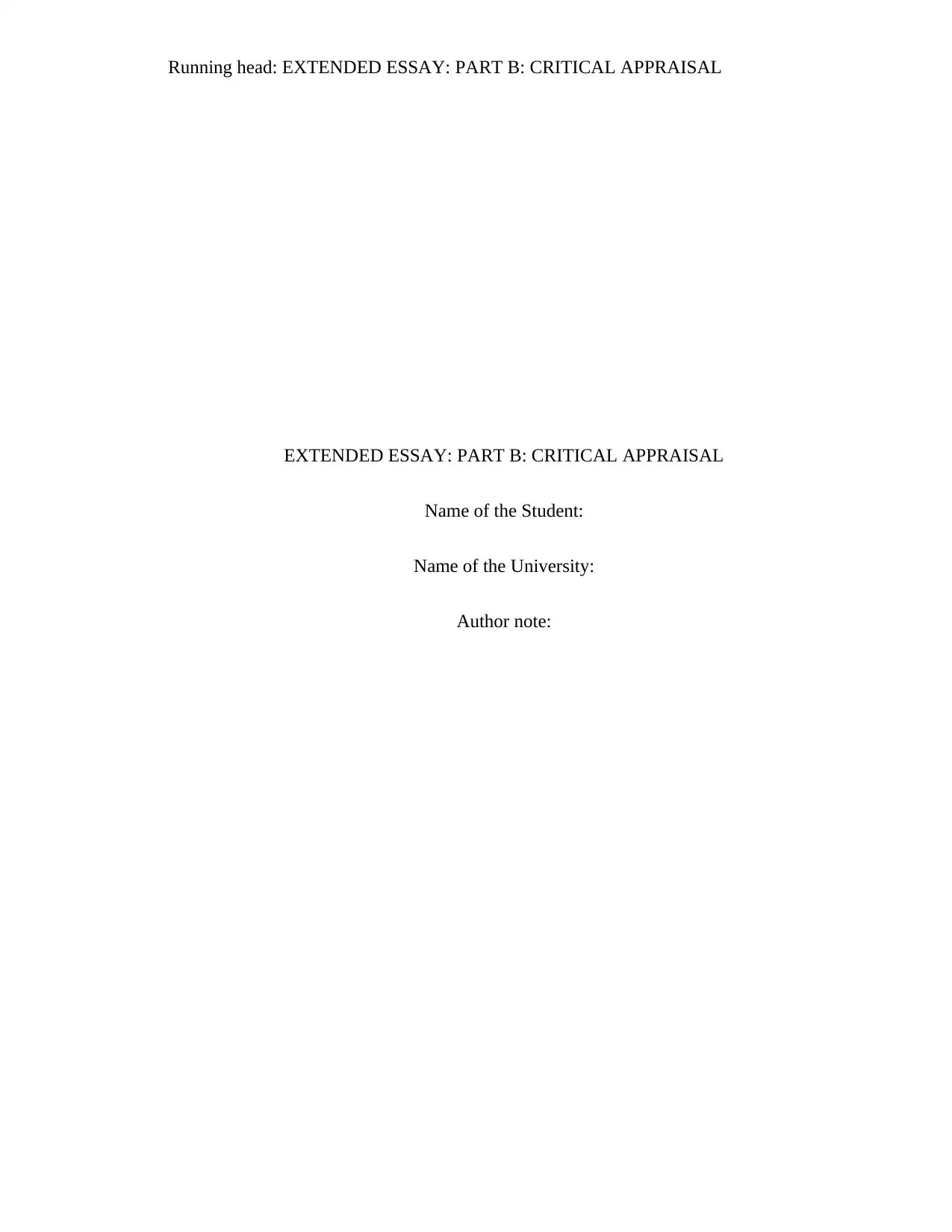
Running head: EXTENDED ESSAY: PART B: CRITICAL APPRAISAL
EXTENDED ESSAY: PART B: CRITICAL APPRAISAL
Name of the Student:
Name of the University:
Author note:
EXTENDED ESSAY: PART B: CRITICAL APPRAISAL
Name of the Student:
Name of the University:
Author note:
Paraphrase This Document
Need a fresh take? Get an instant paraphrase of this document with our AI Paraphraser
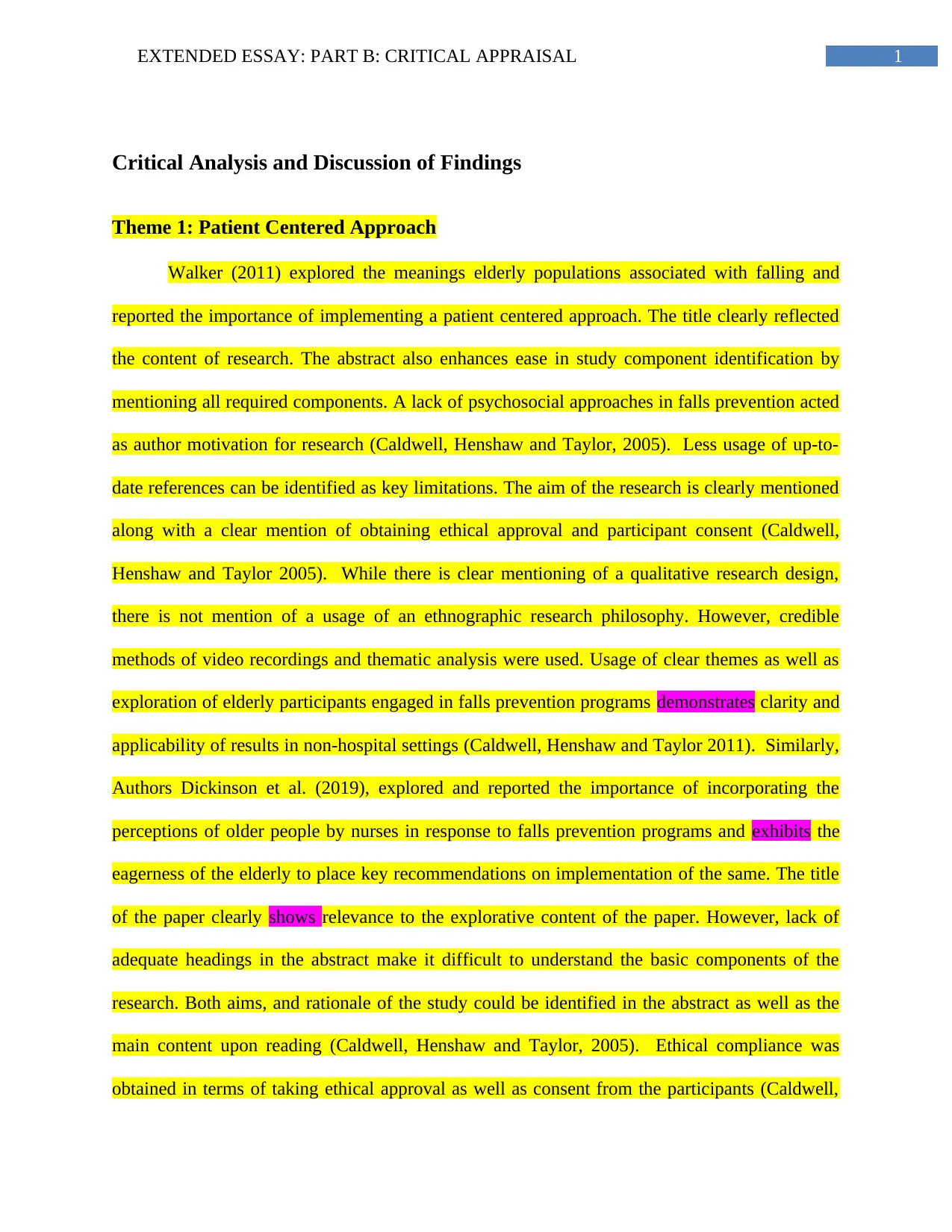
1EXTENDED ESSAY: PART B: CRITICAL APPRAISAL
Critical Analysis and Discussion of Findings
Theme 1: Patient Centered Approach
Walker (2011) explored the meanings elderly populations associated with falling and
reported the importance of implementing a patient centered approach. The title clearly reflected
the content of research. The abstract also enhances ease in study component identification by
mentioning all required components. A lack of psychosocial approaches in falls prevention acted
as author motivation for research (Caldwell, Henshaw and Taylor, 2005). Less usage of up-to-
date references can be identified as key limitations. The aim of the research is clearly mentioned
along with a clear mention of obtaining ethical approval and participant consent (Caldwell,
Henshaw and Taylor 2005). While there is clear mentioning of a qualitative research design,
there is not mention of a usage of an ethnographic research philosophy. However, credible
methods of video recordings and thematic analysis were used. Usage of clear themes as well as
exploration of elderly participants engaged in falls prevention programs demonstrates clarity and
applicability of results in non-hospital settings (Caldwell, Henshaw and Taylor 2011). Similarly,
Authors Dickinson et al. (2019), explored and reported the importance of incorporating the
perceptions of older people by nurses in response to falls prevention programs and exhibits the
eagerness of the elderly to place key recommendations on implementation of the same. The title
of the paper clearly shows relevance to the explorative content of the paper. However, lack of
adequate headings in the abstract make it difficult to understand the basic components of the
research. Both aims, and rationale of the study could be identified in the abstract as well as the
main content upon reading (Caldwell, Henshaw and Taylor, 2005). Ethical compliance was
obtained in terms of taking ethical approval as well as consent from the participants (Caldwell,
Critical Analysis and Discussion of Findings
Theme 1: Patient Centered Approach
Walker (2011) explored the meanings elderly populations associated with falling and
reported the importance of implementing a patient centered approach. The title clearly reflected
the content of research. The abstract also enhances ease in study component identification by
mentioning all required components. A lack of psychosocial approaches in falls prevention acted
as author motivation for research (Caldwell, Henshaw and Taylor, 2005). Less usage of up-to-
date references can be identified as key limitations. The aim of the research is clearly mentioned
along with a clear mention of obtaining ethical approval and participant consent (Caldwell,
Henshaw and Taylor 2005). While there is clear mentioning of a qualitative research design,
there is not mention of a usage of an ethnographic research philosophy. However, credible
methods of video recordings and thematic analysis were used. Usage of clear themes as well as
exploration of elderly participants engaged in falls prevention programs demonstrates clarity and
applicability of results in non-hospital settings (Caldwell, Henshaw and Taylor 2011). Similarly,
Authors Dickinson et al. (2019), explored and reported the importance of incorporating the
perceptions of older people by nurses in response to falls prevention programs and exhibits the
eagerness of the elderly to place key recommendations on implementation of the same. The title
of the paper clearly shows relevance to the explorative content of the paper. However, lack of
adequate headings in the abstract make it difficult to understand the basic components of the
research. Both aims, and rationale of the study could be identified in the abstract as well as the
main content upon reading (Caldwell, Henshaw and Taylor, 2005). Ethical compliance was
obtained in terms of taking ethical approval as well as consent from the participants (Caldwell,

2EXTENDED ESSAY: PART B: CRITICAL APPRAISAL
Henshaw and Taylor 2005). The authors utilized credible qualitative grounded theory
philosophies, focus group research design as well as analytical methods of thematic analysis. The
validity of results may be hindered due to the possibility of bias in interviews (Caldwell,
Henshaw and Taylor 2011).
Theme 2: Non-clinical Interventions
Using performance based self-report measures as well as semi-structured interviews,
authors Fleiget al. (2016), evaluated the feasibility underlying implementation of health
behavior change theory in the form of implementation of a habit based strength exercise and
balance intervention for the purpose of falls prevention. Using framework evaluation, thematic
domains of social factors, knowledge and behavioral regulation along with session facilitation,
group formatting and participant engagement in terms of program administration the findings
proved the beneficial effects of behavior change practices such as strength and balance exercises
on prevention of falls and achievement of positive health outcomes in the elderly. The selected
title clearly reflects content of health behavior change theory and exercise interventions for falls
prevention and demonstrates readability (Caldwell, Henshaw and Taylor 2011).The authors hold
notable positions as university academicians and health consultants hence highlighting
credibility. No segregation for aims and rationale hinders readability (Caldwell, Henshaw and
Taylor, 2005). A major limitation, as noted was lack of currency observed as well as increased
usage of primary studies (Caldwell, Henshaw and Taylor 2011). However, a key advantage was
the authors mentioning a separate section for their aims. The authors demonstrated ethical
compliance by mentioning that consent and approval were obtained from participants. The
authors clearly mentioned usage of a mixed methods approach. However, the authors missed key
points in terms of highlighting hypothesis and research philosophies (Caldwell, Henshaw and
Henshaw and Taylor 2005). The authors utilized credible qualitative grounded theory
philosophies, focus group research design as well as analytical methods of thematic analysis. The
validity of results may be hindered due to the possibility of bias in interviews (Caldwell,
Henshaw and Taylor 2011).
Theme 2: Non-clinical Interventions
Using performance based self-report measures as well as semi-structured interviews,
authors Fleiget al. (2016), evaluated the feasibility underlying implementation of health
behavior change theory in the form of implementation of a habit based strength exercise and
balance intervention for the purpose of falls prevention. Using framework evaluation, thematic
domains of social factors, knowledge and behavioral regulation along with session facilitation,
group formatting and participant engagement in terms of program administration the findings
proved the beneficial effects of behavior change practices such as strength and balance exercises
on prevention of falls and achievement of positive health outcomes in the elderly. The selected
title clearly reflects content of health behavior change theory and exercise interventions for falls
prevention and demonstrates readability (Caldwell, Henshaw and Taylor 2011).The authors hold
notable positions as university academicians and health consultants hence highlighting
credibility. No segregation for aims and rationale hinders readability (Caldwell, Henshaw and
Taylor, 2005). A major limitation, as noted was lack of currency observed as well as increased
usage of primary studies (Caldwell, Henshaw and Taylor 2011). However, a key advantage was
the authors mentioning a separate section for their aims. The authors demonstrated ethical
compliance by mentioning that consent and approval were obtained from participants. The
authors clearly mentioned usage of a mixed methods approach. However, the authors missed key
points in terms of highlighting hypothesis and research philosophies (Caldwell, Henshaw and
⊘ This is a preview!⊘
Do you want full access?
Subscribe today to unlock all pages.

Trusted by 1+ million students worldwide
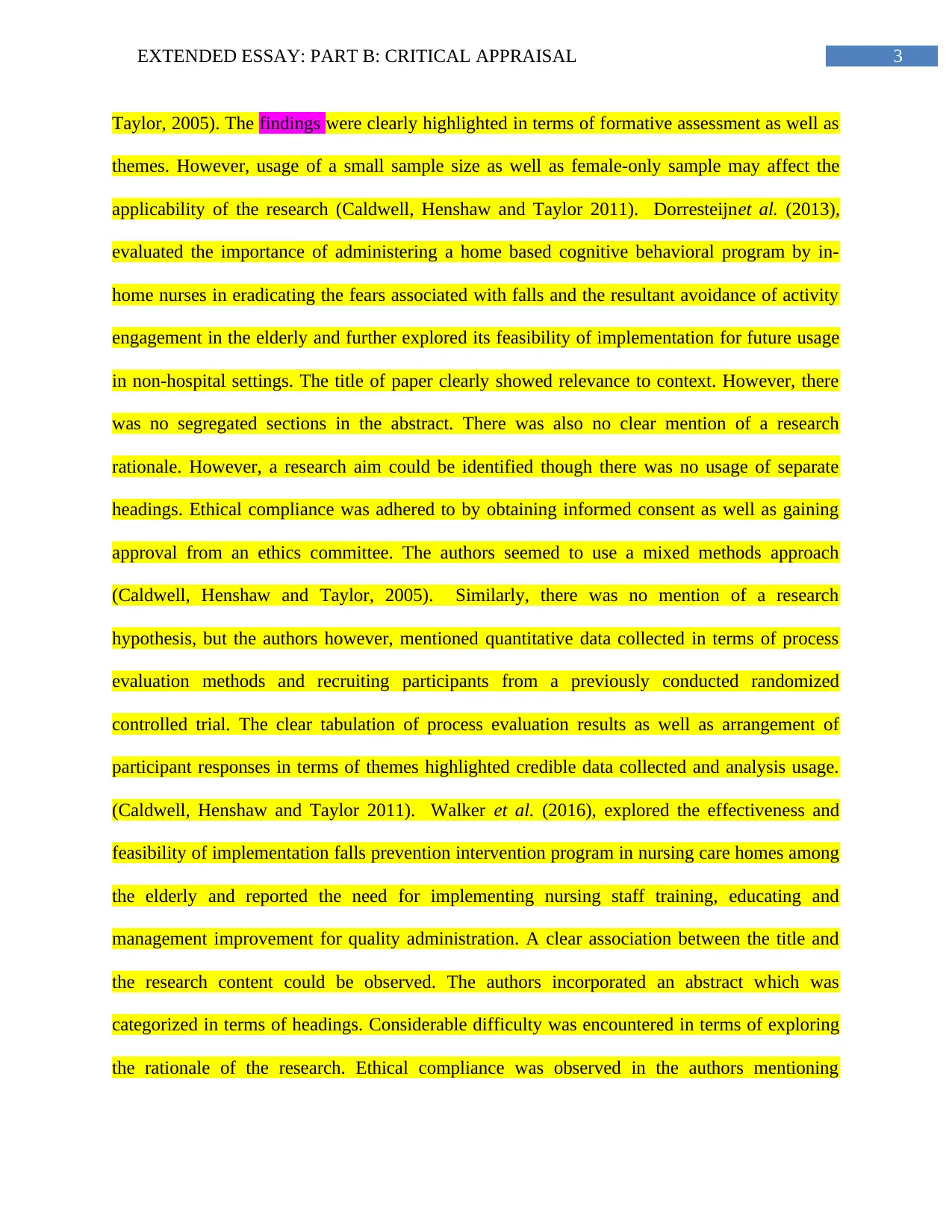
3EXTENDED ESSAY: PART B: CRITICAL APPRAISAL
Taylor, 2005). The findings were clearly highlighted in terms of formative assessment as well as
themes. However, usage of a small sample size as well as female-only sample may affect the
applicability of the research (Caldwell, Henshaw and Taylor 2011). Dorresteijnet al. (2013),
evaluated the importance of administering a home based cognitive behavioral program by in-
home nurses in eradicating the fears associated with falls and the resultant avoidance of activity
engagement in the elderly and further explored its feasibility of implementation for future usage
in non-hospital settings. The title of paper clearly showed relevance to context. However, there
was no segregated sections in the abstract. There was also no clear mention of a research
rationale. However, a research aim could be identified though there was no usage of separate
headings. Ethical compliance was adhered to by obtaining informed consent as well as gaining
approval from an ethics committee. The authors seemed to use a mixed methods approach
(Caldwell, Henshaw and Taylor, 2005). Similarly, there was no mention of a research
hypothesis, but the authors however, mentioned quantitative data collected in terms of process
evaluation methods and recruiting participants from a previously conducted randomized
controlled trial. The clear tabulation of process evaluation results as well as arrangement of
participant responses in terms of themes highlighted credible data collected and analysis usage.
(Caldwell, Henshaw and Taylor 2011). Walker et al. (2016), explored the effectiveness and
feasibility of implementation falls prevention intervention program in nursing care homes among
the elderly and reported the need for implementing nursing staff training, educating and
management improvement for quality administration. A clear association between the title and
the research content could be observed. The authors incorporated an abstract which was
categorized in terms of headings. Considerable difficulty was encountered in terms of exploring
the rationale of the research. Ethical compliance was observed in the authors mentioning
Taylor, 2005). The findings were clearly highlighted in terms of formative assessment as well as
themes. However, usage of a small sample size as well as female-only sample may affect the
applicability of the research (Caldwell, Henshaw and Taylor 2011). Dorresteijnet al. (2013),
evaluated the importance of administering a home based cognitive behavioral program by in-
home nurses in eradicating the fears associated with falls and the resultant avoidance of activity
engagement in the elderly and further explored its feasibility of implementation for future usage
in non-hospital settings. The title of paper clearly showed relevance to context. However, there
was no segregated sections in the abstract. There was also no clear mention of a research
rationale. However, a research aim could be identified though there was no usage of separate
headings. Ethical compliance was adhered to by obtaining informed consent as well as gaining
approval from an ethics committee. The authors seemed to use a mixed methods approach
(Caldwell, Henshaw and Taylor, 2005). Similarly, there was no mention of a research
hypothesis, but the authors however, mentioned quantitative data collected in terms of process
evaluation methods and recruiting participants from a previously conducted randomized
controlled trial. The clear tabulation of process evaluation results as well as arrangement of
participant responses in terms of themes highlighted credible data collected and analysis usage.
(Caldwell, Henshaw and Taylor 2011). Walker et al. (2016), explored the effectiveness and
feasibility of implementation falls prevention intervention program in nursing care homes among
the elderly and reported the need for implementing nursing staff training, educating and
management improvement for quality administration. A clear association between the title and
the research content could be observed. The authors incorporated an abstract which was
categorized in terms of headings. Considerable difficulty was encountered in terms of exploring
the rationale of the research. Ethical compliance was observed in the authors mentioning
Paraphrase This Document
Need a fresh take? Get an instant paraphrase of this document with our AI Paraphraser

4EXTENDED ESSAY: PART B: CRITICAL APPRAISAL
obtaining ethical approval (Caldwell, Henshaw and Taylor, 2005). A key strength was the
incorporation of extensive researches which were recent and of various research designs. The
authors clearly mentioned the research design usage of a randomized controlled trial, which can
be considered credible. Further usage of process evaluation also highlighted the usage of credible
analytical methods. The results can also be considered to possess high generalization due to
exploration of falls prevention program in non-hospital settings. However, considering that this
was a feasibility study, further research is required to understand true applicability (Caldwell,
Henshaw and Taylor 2011). Borland, Martin and Locke (2012), explored qualitatively the
perceptions of nurses considering their understanding of footwear appropriate for preventing
falls in the elderly and reported a lack of adequate understanding and presence of established
care standards in nursing homes. Key strengths of the understanding of the study can be
identified in terms of providing a relevant title as well as a clear abstract with separate headings.
The aim of the study has been mentioned clearly as well as the rationale hence lending high
comprehensiveness and understanding to the research. Ethical compliance was observed in terms
of obtaining consent from the participants as well as ethical approval, along with an
advantageous usage of an extensive reference list containing recent references incorporating a
variety of designs (Caldwell, Henshaw and Taylor, 2005).The authors used credible methods and
analysis of interviews and thematic frameworks. However it must be noted that the research used
a highly small sample size which may affect the rate of applicability (Caldwell, Henshaw and
Taylor 2011).
Theme 3: External Factors
The exploratory research conducted by Nyman et al.(2013), aimed to assess the various
risk factors associated with the incidence of falls in outdoor settings among the elderly, using
obtaining ethical approval (Caldwell, Henshaw and Taylor, 2005). A key strength was the
incorporation of extensive researches which were recent and of various research designs. The
authors clearly mentioned the research design usage of a randomized controlled trial, which can
be considered credible. Further usage of process evaluation also highlighted the usage of credible
analytical methods. The results can also be considered to possess high generalization due to
exploration of falls prevention program in non-hospital settings. However, considering that this
was a feasibility study, further research is required to understand true applicability (Caldwell,
Henshaw and Taylor 2011). Borland, Martin and Locke (2012), explored qualitatively the
perceptions of nurses considering their understanding of footwear appropriate for preventing
falls in the elderly and reported a lack of adequate understanding and presence of established
care standards in nursing homes. Key strengths of the understanding of the study can be
identified in terms of providing a relevant title as well as a clear abstract with separate headings.
The aim of the study has been mentioned clearly as well as the rationale hence lending high
comprehensiveness and understanding to the research. Ethical compliance was observed in terms
of obtaining consent from the participants as well as ethical approval, along with an
advantageous usage of an extensive reference list containing recent references incorporating a
variety of designs (Caldwell, Henshaw and Taylor, 2005).The authors used credible methods and
analysis of interviews and thematic frameworks. However it must be noted that the research used
a highly small sample size which may affect the rate of applicability (Caldwell, Henshaw and
Taylor 2011).
Theme 3: External Factors
The exploratory research conducted by Nyman et al.(2013), aimed to assess the various
risk factors associated with the incidence of falls in outdoor settings among the elderly, using
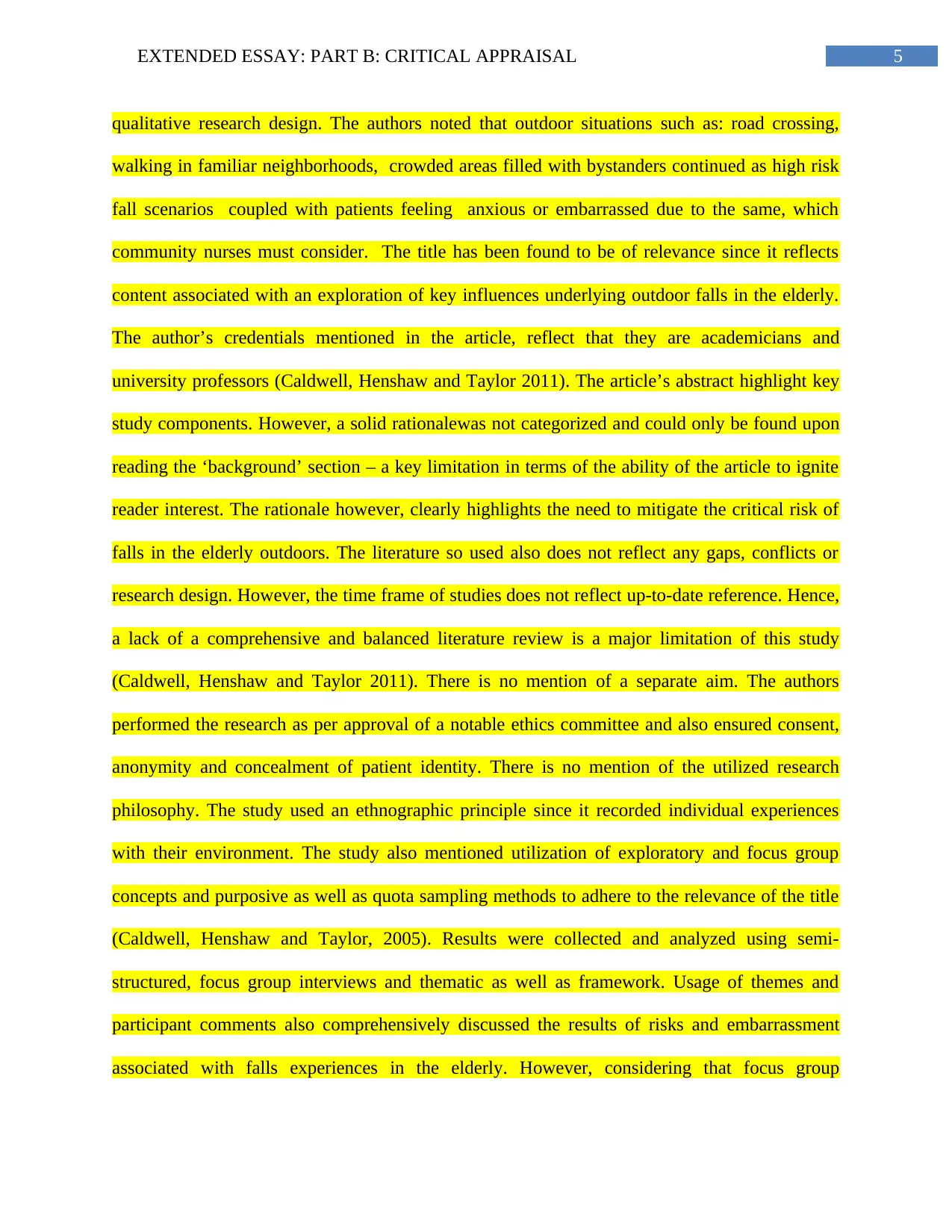
5EXTENDED ESSAY: PART B: CRITICAL APPRAISAL
qualitative research design. The authors noted that outdoor situations such as: road crossing,
walking in familiar neighborhoods, crowded areas filled with bystanders continued as high risk
fall scenarios coupled with patients feeling anxious or embarrassed due to the same, which
community nurses must consider. The title has been found to be of relevance since it reflects
content associated with an exploration of key influences underlying outdoor falls in the elderly.
The author’s credentials mentioned in the article, reflect that they are academicians and
university professors (Caldwell, Henshaw and Taylor 2011). The article’s abstract highlight key
study components. However, a solid rationalewas not categorized and could only be found upon
reading the ‘background’ section – a key limitation in terms of the ability of the article to ignite
reader interest. The rationale however, clearly highlights the need to mitigate the critical risk of
falls in the elderly outdoors. The literature so used also does not reflect any gaps, conflicts or
research design. However, the time frame of studies does not reflect up-to-date reference. Hence,
a lack of a comprehensive and balanced literature review is a major limitation of this study
(Caldwell, Henshaw and Taylor 2011). There is no mention of a separate aim. The authors
performed the research as per approval of a notable ethics committee and also ensured consent,
anonymity and concealment of patient identity. There is no mention of the utilized research
philosophy. The study used an ethnographic principle since it recorded individual experiences
with their environment. The study also mentioned utilization of exploratory and focus group
concepts and purposive as well as quota sampling methods to adhere to the relevance of the title
(Caldwell, Henshaw and Taylor, 2005). Results were collected and analyzed using semi-
structured, focus group interviews and thematic as well as framework. Usage of themes and
participant comments also comprehensively discussed the results of risks and embarrassment
associated with falls experiences in the elderly. However, considering that focus group
qualitative research design. The authors noted that outdoor situations such as: road crossing,
walking in familiar neighborhoods, crowded areas filled with bystanders continued as high risk
fall scenarios coupled with patients feeling anxious or embarrassed due to the same, which
community nurses must consider. The title has been found to be of relevance since it reflects
content associated with an exploration of key influences underlying outdoor falls in the elderly.
The author’s credentials mentioned in the article, reflect that they are academicians and
university professors (Caldwell, Henshaw and Taylor 2011). The article’s abstract highlight key
study components. However, a solid rationalewas not categorized and could only be found upon
reading the ‘background’ section – a key limitation in terms of the ability of the article to ignite
reader interest. The rationale however, clearly highlights the need to mitigate the critical risk of
falls in the elderly outdoors. The literature so used also does not reflect any gaps, conflicts or
research design. However, the time frame of studies does not reflect up-to-date reference. Hence,
a lack of a comprehensive and balanced literature review is a major limitation of this study
(Caldwell, Henshaw and Taylor 2011). There is no mention of a separate aim. The authors
performed the research as per approval of a notable ethics committee and also ensured consent,
anonymity and concealment of patient identity. There is no mention of the utilized research
philosophy. The study used an ethnographic principle since it recorded individual experiences
with their environment. The study also mentioned utilization of exploratory and focus group
concepts and purposive as well as quota sampling methods to adhere to the relevance of the title
(Caldwell, Henshaw and Taylor, 2005). Results were collected and analyzed using semi-
structured, focus group interviews and thematic as well as framework. Usage of themes and
participant comments also comprehensively discussed the results of risks and embarrassment
associated with falls experiences in the elderly. However, considering that focus group
⊘ This is a preview!⊘
Do you want full access?
Subscribe today to unlock all pages.

Trusted by 1+ million students worldwide
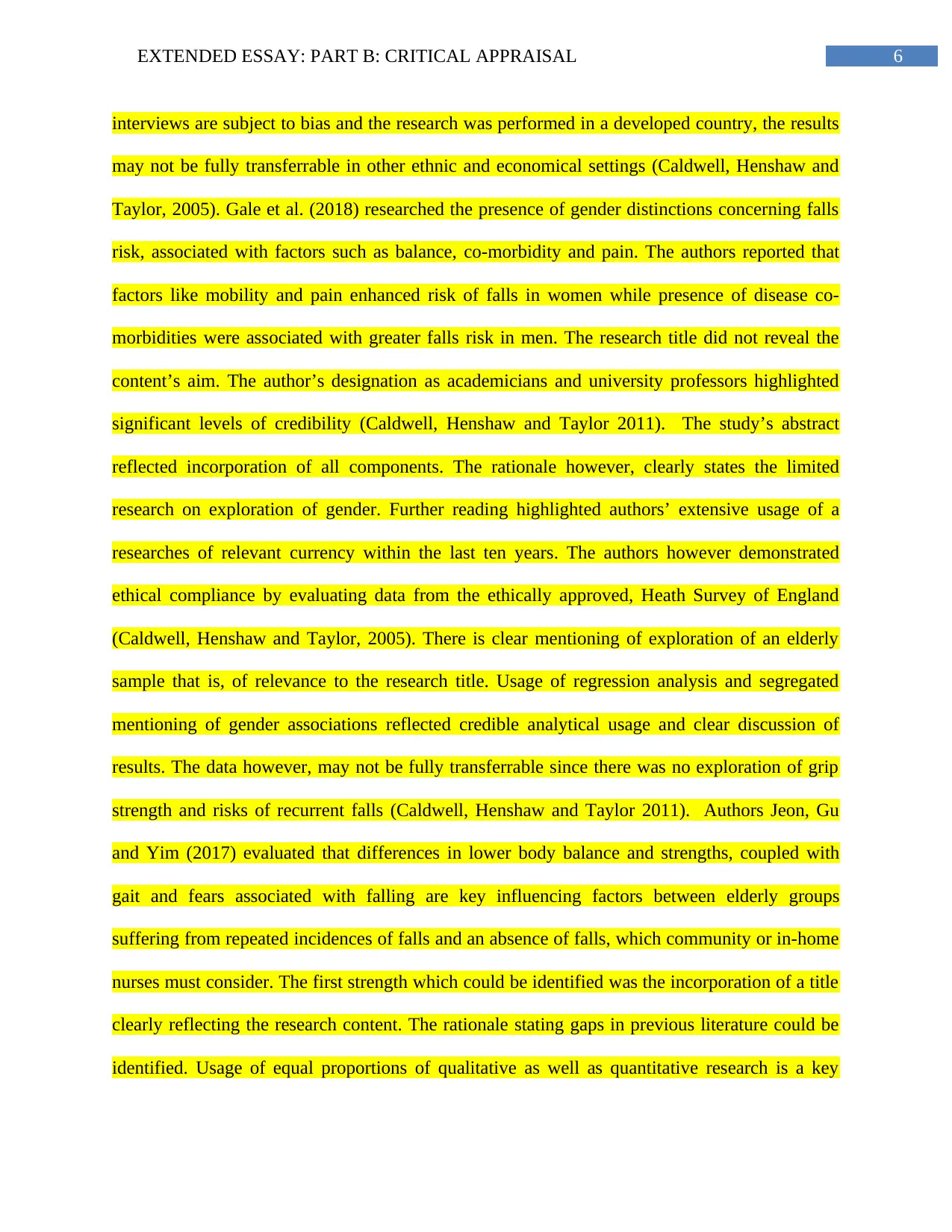
6EXTENDED ESSAY: PART B: CRITICAL APPRAISAL
interviews are subject to bias and the research was performed in a developed country, the results
may not be fully transferrable in other ethnic and economical settings (Caldwell, Henshaw and
Taylor, 2005). Gale et al. (2018) researched the presence of gender distinctions concerning falls
risk, associated with factors such as balance, co-morbidity and pain. The authors reported that
factors like mobility and pain enhanced risk of falls in women while presence of disease co-
morbidities were associated with greater falls risk in men. The research title did not reveal the
content’s aim. The author’s designation as academicians and university professors highlighted
significant levels of credibility (Caldwell, Henshaw and Taylor 2011). The study’s abstract
reflected incorporation of all components. The rationale however, clearly states the limited
research on exploration of gender. Further reading highlighted authors’ extensive usage of a
researches of relevant currency within the last ten years. The authors however demonstrated
ethical compliance by evaluating data from the ethically approved, Heath Survey of England
(Caldwell, Henshaw and Taylor, 2005). There is clear mentioning of exploration of an elderly
sample that is, of relevance to the research title. Usage of regression analysis and segregated
mentioning of gender associations reflected credible analytical usage and clear discussion of
results. The data however, may not be fully transferrable since there was no exploration of grip
strength and risks of recurrent falls (Caldwell, Henshaw and Taylor 2011). Authors Jeon, Gu
and Yim (2017) evaluated that differences in lower body balance and strengths, coupled with
gait and fears associated with falling are key influencing factors between elderly groups
suffering from repeated incidences of falls and an absence of falls, which community or in-home
nurses must consider. The first strength which could be identified was the incorporation of a title
clearly reflecting the research content. The rationale stating gaps in previous literature could be
identified. Usage of equal proportions of qualitative as well as quantitative research is a key
interviews are subject to bias and the research was performed in a developed country, the results
may not be fully transferrable in other ethnic and economical settings (Caldwell, Henshaw and
Taylor, 2005). Gale et al. (2018) researched the presence of gender distinctions concerning falls
risk, associated with factors such as balance, co-morbidity and pain. The authors reported that
factors like mobility and pain enhanced risk of falls in women while presence of disease co-
morbidities were associated with greater falls risk in men. The research title did not reveal the
content’s aim. The author’s designation as academicians and university professors highlighted
significant levels of credibility (Caldwell, Henshaw and Taylor 2011). The study’s abstract
reflected incorporation of all components. The rationale however, clearly states the limited
research on exploration of gender. Further reading highlighted authors’ extensive usage of a
researches of relevant currency within the last ten years. The authors however demonstrated
ethical compliance by evaluating data from the ethically approved, Heath Survey of England
(Caldwell, Henshaw and Taylor, 2005). There is clear mentioning of exploration of an elderly
sample that is, of relevance to the research title. Usage of regression analysis and segregated
mentioning of gender associations reflected credible analytical usage and clear discussion of
results. The data however, may not be fully transferrable since there was no exploration of grip
strength and risks of recurrent falls (Caldwell, Henshaw and Taylor 2011). Authors Jeon, Gu
and Yim (2017) evaluated that differences in lower body balance and strengths, coupled with
gait and fears associated with falling are key influencing factors between elderly groups
suffering from repeated incidences of falls and an absence of falls, which community or in-home
nurses must consider. The first strength which could be identified was the incorporation of a title
clearly reflecting the research content. The rationale stating gaps in previous literature could be
identified. Usage of equal proportions of qualitative as well as quantitative research is a key
Paraphrase This Document
Need a fresh take? Get an instant paraphrase of this document with our AI Paraphraser

7EXTENDED ESSAY: PART B: CRITICAL APPRAISAL
strength. The aims of the study have been clearly mentioned in the abstract as well as the main
content. Incorporation of participant consent as well ethical approval from a university ethical
board (Caldwell, Henshaw and Taylor 2011).The quantitative study design has been clearly
mentioned in terms of usage of a cross sectional descriptive study using valid data collection of
purposive sample recruitment aged above 60. Analysis of variance coupled with usage of tests on
gait, muscle strength and balance highlighted usage of credible analytical methods. The authors’
usage of tables as well as segregation of analysis into separate assessment parameters highlighted
comprehensiveness and clarity (Caldwell, Henshaw and Taylor, 2005). However, the usage of a
relatively small sample size and a controlled setting may affect generalization of findings
(Caldwell, Henshaw and Taylor 2011). Caldwell, Dearmon and VandeWaa (2017), reported the
possibilities of an association between psychotropic medications in dementia patients and the
occurrence of falls in the elderly. The abstract is observed to be incomprehensive. There was also
no clear mention a research aim and rationale (Caldwell, Henshaw and Taylor, 2005). Only 17
references and without any separate literature review section were used, which was a key
limitation. There was hardly any mention of an ethics approval committee or obtaining informed
consent from participants (Caldwell, Henshaw and Taylor 2005). The relatively small sample
size as well as short time period may affect generalization of findings (Caldwell, Henshaw and
Taylor 2011).
Evidence of Ability
A majority of the researches randomized controlled trials - which can be considered high
levels of evidence. However, almost every chosen research displayed extensive limitations in
terms of readability, understating, comprehensiveness and applicability of findings hence
strength. The aims of the study have been clearly mentioned in the abstract as well as the main
content. Incorporation of participant consent as well ethical approval from a university ethical
board (Caldwell, Henshaw and Taylor 2011).The quantitative study design has been clearly
mentioned in terms of usage of a cross sectional descriptive study using valid data collection of
purposive sample recruitment aged above 60. Analysis of variance coupled with usage of tests on
gait, muscle strength and balance highlighted usage of credible analytical methods. The authors’
usage of tables as well as segregation of analysis into separate assessment parameters highlighted
comprehensiveness and clarity (Caldwell, Henshaw and Taylor, 2005). However, the usage of a
relatively small sample size and a controlled setting may affect generalization of findings
(Caldwell, Henshaw and Taylor 2011). Caldwell, Dearmon and VandeWaa (2017), reported the
possibilities of an association between psychotropic medications in dementia patients and the
occurrence of falls in the elderly. The abstract is observed to be incomprehensive. There was also
no clear mention a research aim and rationale (Caldwell, Henshaw and Taylor, 2005). Only 17
references and without any separate literature review section were used, which was a key
limitation. There was hardly any mention of an ethics approval committee or obtaining informed
consent from participants (Caldwell, Henshaw and Taylor 2005). The relatively small sample
size as well as short time period may affect generalization of findings (Caldwell, Henshaw and
Taylor 2011).
Evidence of Ability
A majority of the researches randomized controlled trials - which can be considered high
levels of evidence. However, almost every chosen research displayed extensive limitations in
terms of readability, understating, comprehensiveness and applicability of findings hence
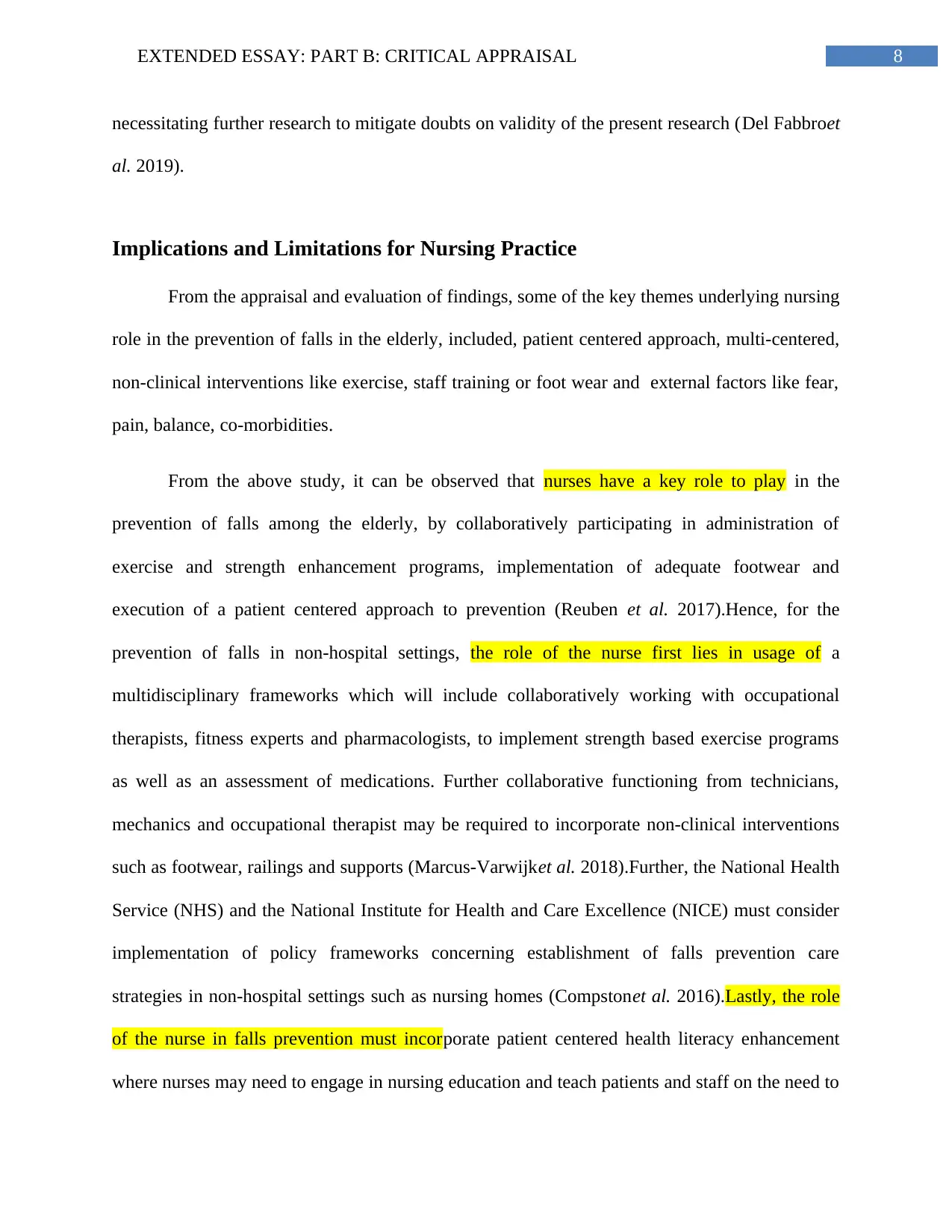
8EXTENDED ESSAY: PART B: CRITICAL APPRAISAL
necessitating further research to mitigate doubts on validity of the present research (Del Fabbroet
al. 2019).
Implications and Limitations for Nursing Practice
From the appraisal and evaluation of findings, some of the key themes underlying nursing
role in the prevention of falls in the elderly, included, patient centered approach, multi-centered,
non-clinical interventions like exercise, staff training or foot wear and external factors like fear,
pain, balance, co-morbidities.
From the above study, it can be observed that nurses have a key role to play in the
prevention of falls among the elderly, by collaboratively participating in administration of
exercise and strength enhancement programs, implementation of adequate footwear and
execution of a patient centered approach to prevention (Reuben et al. 2017).Hence, for the
prevention of falls in non-hospital settings, the role of the nurse first lies in usage of a
multidisciplinary frameworks which will include collaboratively working with occupational
therapists, fitness experts and pharmacologists, to implement strength based exercise programs
as well as an assessment of medications. Further collaborative functioning from technicians,
mechanics and occupational therapist may be required to incorporate non-clinical interventions
such as footwear, railings and supports (Marcus-Varwijket al. 2018).Further, the National Health
Service (NHS) and the National Institute for Health and Care Excellence (NICE) must consider
implementation of policy frameworks concerning establishment of falls prevention care
strategies in non-hospital settings such as nursing homes (Compstonet al. 2016).Lastly, the role
of the nurse in falls prevention must incorporate patient centered health literacy enhancement
where nurses may need to engage in nursing education and teach patients and staff on the need to
necessitating further research to mitigate doubts on validity of the present research (Del Fabbroet
al. 2019).
Implications and Limitations for Nursing Practice
From the appraisal and evaluation of findings, some of the key themes underlying nursing
role in the prevention of falls in the elderly, included, patient centered approach, multi-centered,
non-clinical interventions like exercise, staff training or foot wear and external factors like fear,
pain, balance, co-morbidities.
From the above study, it can be observed that nurses have a key role to play in the
prevention of falls among the elderly, by collaboratively participating in administration of
exercise and strength enhancement programs, implementation of adequate footwear and
execution of a patient centered approach to prevention (Reuben et al. 2017).Hence, for the
prevention of falls in non-hospital settings, the role of the nurse first lies in usage of a
multidisciplinary frameworks which will include collaboratively working with occupational
therapists, fitness experts and pharmacologists, to implement strength based exercise programs
as well as an assessment of medications. Further collaborative functioning from technicians,
mechanics and occupational therapist may be required to incorporate non-clinical interventions
such as footwear, railings and supports (Marcus-Varwijket al. 2018).Further, the National Health
Service (NHS) and the National Institute for Health and Care Excellence (NICE) must consider
implementation of policy frameworks concerning establishment of falls prevention care
strategies in non-hospital settings such as nursing homes (Compstonet al. 2016).Lastly, the role
of the nurse in falls prevention must incorporate patient centered health literacy enhancement
where nurses may need to engage in nursing education and teach patients and staff on the need to
⊘ This is a preview!⊘
Do you want full access?
Subscribe today to unlock all pages.

Trusted by 1+ million students worldwide

9EXTENDED ESSAY: PART B: CRITICAL APPRAISAL
adhere to falls prevention intervention like footwear, medications and exercise and the need for
monitoring using assessment, screening and timely observations as well as evaluation of
patient’s fear, gait, balance pain or co-morbidities (King et al. 2016). However, lack of adequate
information, awareness and education on risk factors and importance of falls prevention
strategies coupled with financial constraints prove to be key factors contributing as barriers to
nursing practice of falls prevention in the elderly in non-hospital settings (Hagan and Jones
2015). Hence, qualified nurses aiming to implement falls prevention among older adults engaged
in non-hospital settings, must be educated in terms of risk factors which may cause falls as well
as external factors like the presence of co-morbidities and pain in occurrence of the same.
Further, it is also required for qualified nurses to be educated on extensively working with
additional health professionals like occupational therapists, fitness experts and counselors to not
only adhere to mitigate of these external factors but also ensure eradication of patients;’
perception of fear, agitation and anxiety upon experiencing incidences related to falls and
associated injuries (Cangany et al., 2015). Dorresteijnet al. (2013), via administration of a
cognitive learning program, ensure compliance to the nursing ethical principles of beneficence
and non-malficence since such interventions not only ensure prevention of harm to the patient by
encountering falls but also ensure long term benefits to the patient and consideration of
physiological and psychological wellbeing.
Ethical Considerations
During performance of the research process, a key ethical considerations were
considered. One of the first aspects of ethical consideration is the presence of an ethics
committee. The role of the ethics committee is essential to ensure participant awareness of the
adhere to falls prevention intervention like footwear, medications and exercise and the need for
monitoring using assessment, screening and timely observations as well as evaluation of
patient’s fear, gait, balance pain or co-morbidities (King et al. 2016). However, lack of adequate
information, awareness and education on risk factors and importance of falls prevention
strategies coupled with financial constraints prove to be key factors contributing as barriers to
nursing practice of falls prevention in the elderly in non-hospital settings (Hagan and Jones
2015). Hence, qualified nurses aiming to implement falls prevention among older adults engaged
in non-hospital settings, must be educated in terms of risk factors which may cause falls as well
as external factors like the presence of co-morbidities and pain in occurrence of the same.
Further, it is also required for qualified nurses to be educated on extensively working with
additional health professionals like occupational therapists, fitness experts and counselors to not
only adhere to mitigate of these external factors but also ensure eradication of patients;’
perception of fear, agitation and anxiety upon experiencing incidences related to falls and
associated injuries (Cangany et al., 2015). Dorresteijnet al. (2013), via administration of a
cognitive learning program, ensure compliance to the nursing ethical principles of beneficence
and non-malficence since such interventions not only ensure prevention of harm to the patient by
encountering falls but also ensure long term benefits to the patient and consideration of
physiological and psychological wellbeing.
Ethical Considerations
During performance of the research process, a key ethical considerations were
considered. One of the first aspects of ethical consideration is the presence of an ethics
committee. The role of the ethics committee is essential to ensure participant awareness of the
Paraphrase This Document
Need a fresh take? Get an instant paraphrase of this document with our AI Paraphraser

10EXTENDED ESSAY: PART B: CRITICAL APPRAISAL
objectives, methods and rationale underlying the research. The researches so selected were
checked and ensured of the presence of an ethics committee and hence, resulted in the overall
performance of an ethical health research (Terkamo-Moisio et al. 2015). Further to ensure ethical
compliance, the key requirement of a nursing health research is the consideration of the nursing
ethical values of autonomy, beneficence, non-malfeasance, informed consent and justice. Hence,
each of the studies so selected, were evaluated extensively to observe the presence of these
components. Further, in order to incorporate, all of the above interventions for falls prevention in
nursing practice, nurses must ensure that consent is obtained from patients prior to
implementation and that just and fair nursing practices are used, for the benefit of the patient
(Wrightet al. 2010). Similarly, key ethical considerations in the chosen researches were
evaluated in terms of the research ethics wheel, where all of the chosen articles displayed
adherence to the same. Likewise, as per the ethics wheel, the nurse must ensure incorporation of
evidence based scientific knowledge during the administration of falls prevention strategies as
mentioned above in non-hospital settings (Leach, Hofmeyer and Bobridge 2016). Further, as per
ethical requirements and considerations, the nurse must ensure that the chosen falls prevention
interventions to be implemented in non-hospital settings are evaluated, not only by an ethics
committee but also an ethics governance framework (Fontenlaand Rycroft-Malone 2006).
Considering the studies which have been incorporated for critical appraisal, it can be
observed that the most of the studies extensively incorporated principles of ethical compliance.
Dickinson et al., (2010) was found to extensively adhere to the principles of ethical compliance
by obtaining ethical approval from an ethics committee – the body responsible for ensuring
author’s adherence to respecting the needs of the participants. Similarly, ethical compliance was
observed in Walker (2011) where the author adhere to ethically conducting the research by
objectives, methods and rationale underlying the research. The researches so selected were
checked and ensured of the presence of an ethics committee and hence, resulted in the overall
performance of an ethical health research (Terkamo-Moisio et al. 2015). Further to ensure ethical
compliance, the key requirement of a nursing health research is the consideration of the nursing
ethical values of autonomy, beneficence, non-malfeasance, informed consent and justice. Hence,
each of the studies so selected, were evaluated extensively to observe the presence of these
components. Further, in order to incorporate, all of the above interventions for falls prevention in
nursing practice, nurses must ensure that consent is obtained from patients prior to
implementation and that just and fair nursing practices are used, for the benefit of the patient
(Wrightet al. 2010). Similarly, key ethical considerations in the chosen researches were
evaluated in terms of the research ethics wheel, where all of the chosen articles displayed
adherence to the same. Likewise, as per the ethics wheel, the nurse must ensure incorporation of
evidence based scientific knowledge during the administration of falls prevention strategies as
mentioned above in non-hospital settings (Leach, Hofmeyer and Bobridge 2016). Further, as per
ethical requirements and considerations, the nurse must ensure that the chosen falls prevention
interventions to be implemented in non-hospital settings are evaluated, not only by an ethics
committee but also an ethics governance framework (Fontenlaand Rycroft-Malone 2006).
Considering the studies which have been incorporated for critical appraisal, it can be
observed that the most of the studies extensively incorporated principles of ethical compliance.
Dickinson et al., (2010) was found to extensively adhere to the principles of ethical compliance
by obtaining ethical approval from an ethics committee – the body responsible for ensuring
author’s adherence to respecting the needs of the participants. Similarly, ethical compliance was
observed in Walker (2011) where the author adhere to ethically conducting the research by
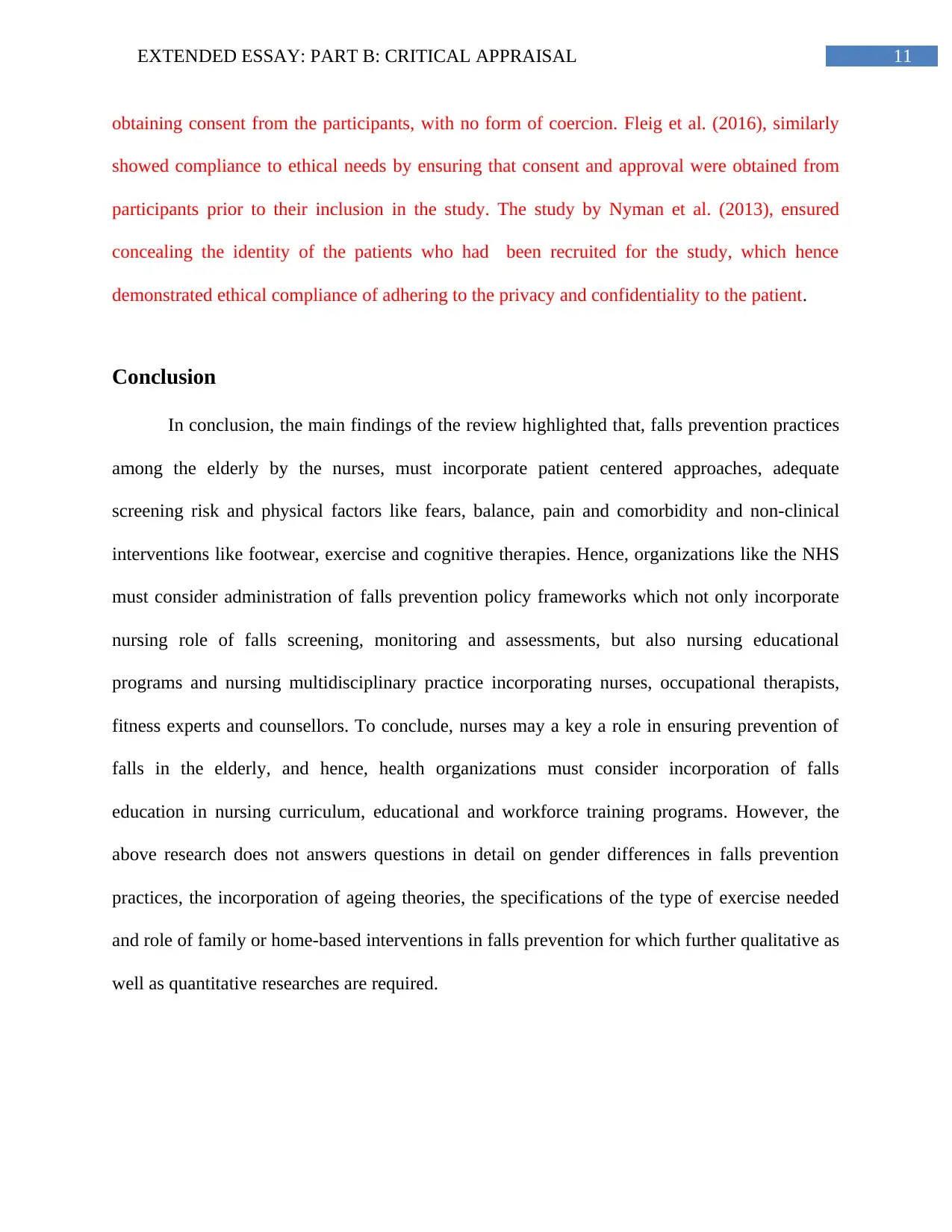
11EXTENDED ESSAY: PART B: CRITICAL APPRAISAL
obtaining consent from the participants, with no form of coercion. Fleig et al. (2016), similarly
showed compliance to ethical needs by ensuring that consent and approval were obtained from
participants prior to their inclusion in the study. The study by Nyman et al. (2013), ensured
concealing the identity of the patients who had been recruited for the study, which hence
demonstrated ethical compliance of adhering to the privacy and confidentiality to the patient.
Conclusion
In conclusion, the main findings of the review highlighted that, falls prevention practices
among the elderly by the nurses, must incorporate patient centered approaches, adequate
screening risk and physical factors like fears, balance, pain and comorbidity and non-clinical
interventions like footwear, exercise and cognitive therapies. Hence, organizations like the NHS
must consider administration of falls prevention policy frameworks which not only incorporate
nursing role of falls screening, monitoring and assessments, but also nursing educational
programs and nursing multidisciplinary practice incorporating nurses, occupational therapists,
fitness experts and counsellors. To conclude, nurses may a key a role in ensuring prevention of
falls in the elderly, and hence, health organizations must consider incorporation of falls
education in nursing curriculum, educational and workforce training programs. However, the
above research does not answers questions in detail on gender differences in falls prevention
practices, the incorporation of ageing theories, the specifications of the type of exercise needed
and role of family or home-based interventions in falls prevention for which further qualitative as
well as quantitative researches are required.
obtaining consent from the participants, with no form of coercion. Fleig et al. (2016), similarly
showed compliance to ethical needs by ensuring that consent and approval were obtained from
participants prior to their inclusion in the study. The study by Nyman et al. (2013), ensured
concealing the identity of the patients who had been recruited for the study, which hence
demonstrated ethical compliance of adhering to the privacy and confidentiality to the patient.
Conclusion
In conclusion, the main findings of the review highlighted that, falls prevention practices
among the elderly by the nurses, must incorporate patient centered approaches, adequate
screening risk and physical factors like fears, balance, pain and comorbidity and non-clinical
interventions like footwear, exercise and cognitive therapies. Hence, organizations like the NHS
must consider administration of falls prevention policy frameworks which not only incorporate
nursing role of falls screening, monitoring and assessments, but also nursing educational
programs and nursing multidisciplinary practice incorporating nurses, occupational therapists,
fitness experts and counsellors. To conclude, nurses may a key a role in ensuring prevention of
falls in the elderly, and hence, health organizations must consider incorporation of falls
education in nursing curriculum, educational and workforce training programs. However, the
above research does not answers questions in detail on gender differences in falls prevention
practices, the incorporation of ageing theories, the specifications of the type of exercise needed
and role of family or home-based interventions in falls prevention for which further qualitative as
well as quantitative researches are required.
⊘ This is a preview!⊘
Do you want full access?
Subscribe today to unlock all pages.

Trusted by 1+ million students worldwide
1 out of 16
Your All-in-One AI-Powered Toolkit for Academic Success.
+13062052269
info@desklib.com
Available 24*7 on WhatsApp / Email
![[object Object]](/_next/static/media/star-bottom.7253800d.svg)
Unlock your academic potential
Copyright © 2020–2025 A2Z Services. All Rights Reserved. Developed and managed by ZUCOL.
